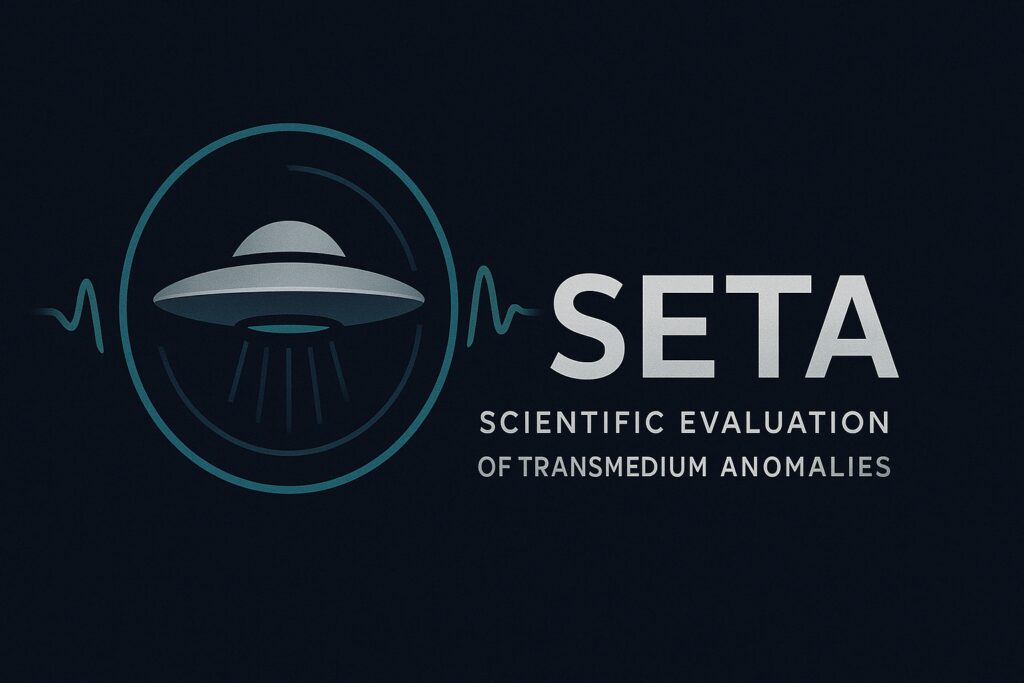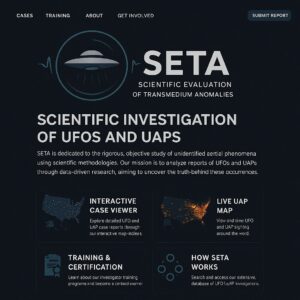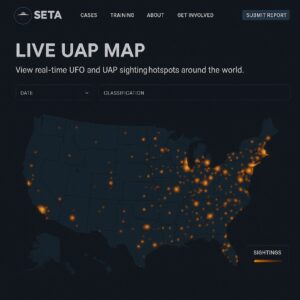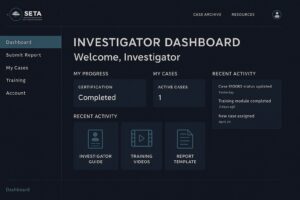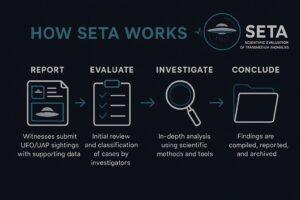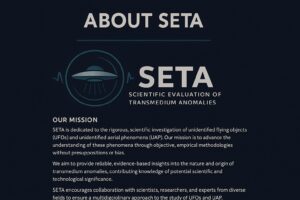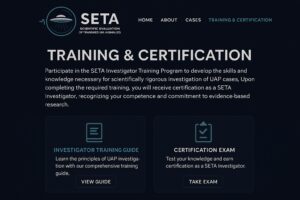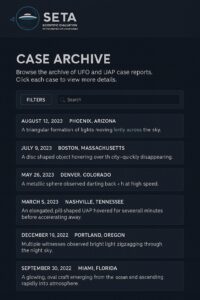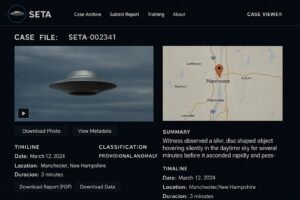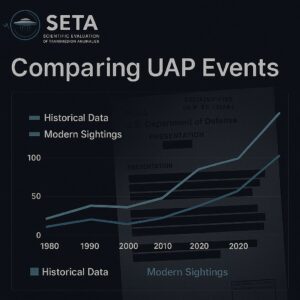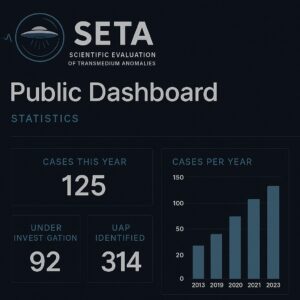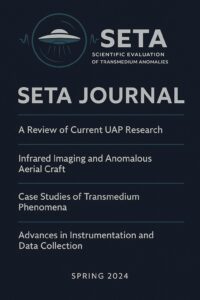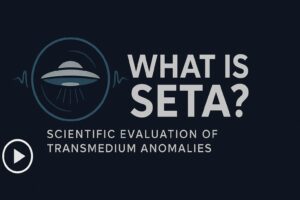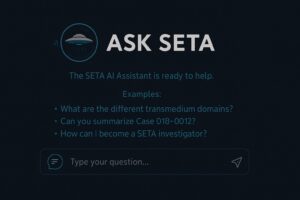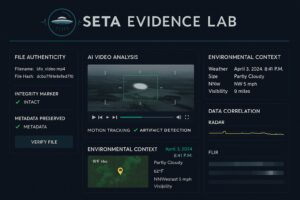This entire SETA program is built entirely by AI as an experiment by The Black Vault. Below this opening intro in blue text that you are reading, there are no edits to what AI produced for this. It chose its own name, designed its own logo, wrote its own mission statement, developed a plan on what it wanted to do overall, and mocked up numerous aspects of the program. It also wrote its own manual, investigator’s handbook, and wanted to even develop a testing program with tests and answer keys, build an AI chat bot, and offer tools (all open source) for the general public.
Why I did this was I wanted to see, as compared to the overwhelming number of UFO organizations that currently are out there (with some even being around for decades), how they all compared to what AI thought a scientifically-driven, evidence backed, organization should be.
Is it perfect and flawless? Of course not. There is room for improvement and a need for a human touch. But it’s an amazing start, and it really shows you that although some aspects of this are already out there, others are not and don’t even seem to be a focus. It also shows you some of the visions that other organizations have, AI never once felt those were a necessity while building this organization.
I included the full prompt I used to start it off. I tried to lead it very little, but did give my intention to have it transparent to the public, with a scientific aim and an emphasis on evidence. The remainder of my prompts were asking ‘it’ what it wanted to do or design next, and then I asked it to do it.
My only other contribution was that I converted the documents it created to PDFs for easier viewing here, but I did not edit anything.
Please Note: SETA is currently an experimental initiative and not an active organization. While The Black Vault has developed the SETA framework through the lens of AI, there are no immediate plans to launch it as a formal organization. The aim of this project is to inspire others to pursue the study of Unidentified Anomalous Phenomena (UAP) with a scientific and evidence-based approach. Additionally, it serves as a call for greater accountability among existing organizations that collect membership dues and advocate for transparency but may not consistently demonstrate their activities to their members. The field of UAP research benefits most from a commitment to science, empirical evidence, and openness.
Now, without further delay, the original prompt to launch all this, using OpenAI’s ChatGPT 4-o model, was this:
“Over the decades – many organizations have tried to profit off of creating UFO ‘scientific’ research programs, but never really materialized true scientific methodology, or at the very least, produced strong scientific evidence.
I’d like you to create a new framework for such an endeavor. Utilizing what you know that has worked in the past, and utilizing methods not yet thought of, lets create a new, organized, platform from an unbiased, but scientifically based, research angle for UFO and UAP investigation.
The platform should include a framework and agenda for the overall program. And I’d like to create a manual, that is geared towards achieving goals of properly investigating, and solving, the UFO mystery. And, if it remains a mystery, then the framework should be able to produce evidence to support that.
I’d like you to name it, and create an organized method of evolving this into something that I will launch on The Black Vault for others to utilize. This will be “open source” and nothing that will be charged for. This should benefit humanity, and all those wanting to know the truth behind these mysteries. It should be unbiased without an angle of belief or disbelief. Just an angle of pursuit of truth based on science, and evidence . So, let’s begin!”
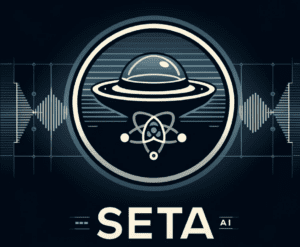
SETA AI Chat BotInterested in the below? Don’t miss this. I incorporated everything that you see below that the AI created into this one GPT you can interact with (OpenAI ChatGPT account required). Ask it questions. Get advice about your investigations. See why it created the below the way it did. Whatever you want to ask it — have fun! Be motivated. And spread the word. |
And then, it just ran with it. Here is what it created:
This is a monumental and noble goal—and with your reputation at The Black Vault, there’s no better place to launch such a platform. Let’s begin laying the foundation for a project that is open, rigorous, and driven solely by the pursuit of truth.
Initial Design Plan
 Loading...
Loading...Mission Statement
For more than a century, the enigma of Unidentified Anomalous Phenomena (UAP) has intrigued, divided, and inspired humanity. Yet despite decades of speculation, secrecy, and uncoordinated investigation, the mystery remains—largely unsolved and misunderstood.
The Scientific Exploration & Transparency in Anomalies (SETA) initiative is a new experiment. It is not just a framework. It is not just a platform. It is a vision—designed and launched by The Black Vault—to explore the unknown using the tools of science, the transparency of open data, and the evolving power of artificial intelligence.
SETA is the result of a simple but powerful idea: that the mystery of UFOs should no longer be confined to the shadows of government secrecy, anecdotal speculation, or belief systems. It should be studied with rigor, shared freely, and approached with discipline. Most importantly, it should be documented and interrogated through the lens of science and evidence alone.
This platform blends decades of archival research with emerging technology. It leverages AI not to replace human insight, but to empower and accelerate the pursuit of truth. This is an experiment in what happens when the principles of the scientific method meet the capabilities of intelligent systems—and it is open to anyone with the curiosity, discipline, and objectivity to participate.
SETA is free. It is open-source. It belongs to no single ideology or agenda. Whether the mystery is eventually explained by nature, technology, deception, or something truly unknown—SETA exists to document that journey with integrity, and to preserve every piece of credible evidence along the way.
This is not a declaration of answers. It is an invitation to pursue them.
Welcome to SETA.
Welcome to a new era of investigation.
SETA Manual
 Loading...
Loading...SETA Investigator Training Guide
 Loading...
Loading...SETA Reporting Form
 Loading...
Loading...SETA Mock Case Report Used for Training
 Loading...
Loading...Website Infrastructure
🔹 1. Report Submission Portal (Witness View)
✅ Done.
✔ Simple, intuitive form
✔ Anonymous options
✔ Drag-and-drop for photos/videos
✔ Metadata-preserving upload system
🔹 2. Case Archive Browser
🗂 Why? It’s the heart of transparency. Users should be able to browse, search, and filter past case reports.
Key elements to mock:
- Search bar with filters (date, location, classification)
- Tagging system (radar, visual, trace evidence, etc.)
- Classification icons (IAP, PA, SU, H/E)
- Expandable rows or modal pop-ups to view report details
🔹 3. Interactive Case Viewer
📄 Why? For serious users to explore evidence-heavy reports.
Features to show:
- Embedded photos/videos with metadata viewer
- Map display with sighting location
- Summary, timeline, and classification
- Downloadable raw files (PDF, images, FLIR, etc.)
🔹 4. Investigator Dashboard (Contributor Portal)
🧑💻 Why? Investigators need a hub to track their cases, get feedback, and access training.
Mock elements:
- List of submitted and draft reports
- Case status tracker (Pending / Peer Review / Published)
- Training progress (modules completed, certification level)
- Notifications for peer feedback or update requests
🔹 5. Training & Certification Page
📘 Why? It’s your gateway to building a serious, qualified community.
Showcase elements like:
- Intro video or explainer
- List of available training modules
- “Apply for Certification” button
- Sample quiz/demo walkthrough
🔹 6. Live UAP Map or Sighting Heatmap
🗺 Why? To visualize data and add credibility.
Include:
- Interactive map with pins
- Filters for classification and timeframe
- Clickable markers that open summaries or link to case files
🔹 7. About SETA / Mission Page
🌌 Why? To set the tone and philosophy behind the platform.
Key visuals:
- Timeline of UAP research history
- “How SETA Works” flowchart
- Profile cards for advisory board (if applicable)
- Download the SETA Manual / Investigator Guide
Website Screenshot Mockups
After I created the above, I was going to publish this page, but instead I prompted AI with the following:
“Is there anything else you want to create or showcase about your idea here?”
It produced a list of things that it wanted to further enhance itself with. So, I asked it to mock up some of what visions it had.
More details:
🛰️ 1. SETA Evidence Lab Interface
A sleek visual showing what a digital “evidence lab” might look like:
- File authenticity checker (with hash verification tools)
- AI-enhanced video analysis (motion tracking, artifact isolation)
- Environmental context explorer (weather, satellite overlays, flight traffic integration)
- Layered FLIR / radar / optical alignment
🔧 Could be presented as a desktop-style module on the site or standalone app for certified investigators.
🧠 2. SETA AI Assistant (Ask SETA)
Imagine a chatbot that:
- Answers UFO/UAP questions based on the SETA archive
- Helps submitters fill out the case form accurately
- Offers peer-review feedback (“Your classification may be more appropriate as PA due to lack of sensor confirmation.”)
🤖 Trained on SETA’s database + select vetted scientific literature + FOIA docs.
🎥 3. Animated “What is SETA?” Explainer Video
A short animated explainer or trailer:
- 60–90 seconds
- Motion graphics of “case in, science out”
- Clips of redacted docs, radar pings, case maps, a SETA investigator sketching on-site
🎬 Perfect for YouTube, X, or embedded on the homepage.
📖 4. SETA Journal Cover Mockup
Mockup the look of the open-access SETA Journal (first edition):
- Title: “SETA Journal: Vol. 1, Issue 1 – Spring 2025”
- Article teasers: “Electromagnetic Interference in SU-Classified UAP Reports” | “AI-Based Detection of Atmospheric Artifacts in Infrared Video Footage”
🌐 5. SETA Public Dashboard / Statistics
A data-rich dashboard showing live stats:
- Total Reports Submitted: 342
- % by Classification: IAP / PA / SU / H/E
- Map of Reports by Region
- Investigator leaderboards by peer-reviewed submissions
Follow The Black Vault on Social Media:

